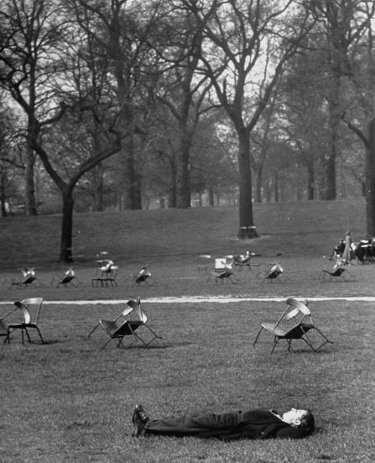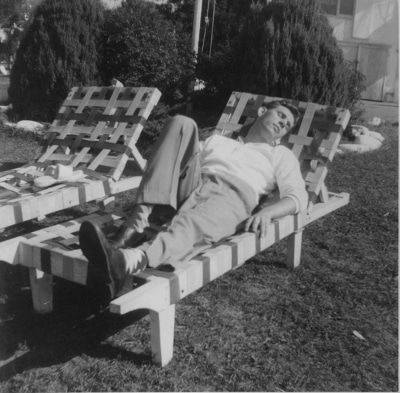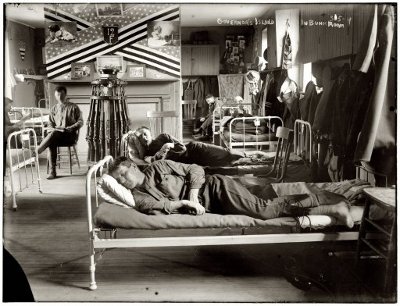
I’ve detailed elsewhere how hard I worked in law school. But there was another secret to my success that I haven’t mentioned yet: the nap.
In law school, I rented a carrel where I kept my books and studied in-between classes. I started learning about the benefits of napping and wanted to incorporate the nap into my routine. But alas, the law school didn’t really have any good couches to sprawl out on. So I improvised. I brought a pillow and blanket from home and put them under my carrel desk. When I was ready for a nap, I simply put my iPod headphones on, put on some nice relaxing music, and slipped under my carrel for a quick nap.
It was awesome. It was nice and dark underneath my desk and because it was in the library, it was quiet. I’m sure some people thought I was a crazy bum or something, but I didn’t care. Those short little naps allowed me to power through hours of classes, reading, and outlining.
Sadly, napping is often frowned upon in our workaholic American culture. When we think of napping men we think of Dagwood passed out on the couch after consuming a giant, delicious sandwich. Naps are for the lazy and unambitious. Or for retirees with plenty of time on their hands. The man who falls asleep at his desk at work is laughed at. And when we doze off, we feel guilty.
But in reality, the nap stigma is incredibly misplaced. Naps can be one of the most powerful tools for self-improvement; they can increase not only our health and well-being but our intelligence and productivity as well. This is something great men have known all along. History is full of famous nappers. Famous thinkers and leaders like Edison, JFK, Churchill, and Napoleon were all ardent nappers. We’ll cover the specific napping habits of famous men in a future post.
Your Cat Knows Something You Don’t
Humans are among the few animals that take their sleep in one shot. The rest of the animal kingdom consists of polyphasic sleepers; they alternate sleep and wake cycles throughout a 24 hour period. Cavemen likely slept in multiple phases too, so someone was always up to keep an eye out for saber tooth tigers. While experimenting with a return to polyphasic sleep has become trendy in recent times, the ideal pattern for human sleep is biphasic–a long stretch at night along with a shorter respite during the day.
The ancient Romans were biphasic sleepers; at sexta (the sixth hour or their noon) everyone would turn in for some midday shut eye. This is where we get the term siesta, a tradition once popular in countries like Spain but which has largely succumbed to the encroaching go-go-go Western business style.
While the pace of modern life may keep us from being the biphasic sleepers we were meant to be, the urge for a daytime snooze is still hardwired into our biology. Studies have shown that when people are put into an environment that lacks any indication of time, they will fall into the long sleep at night/shorter nap during the day pattern. Thus most of us are daily fighting tooth and nail against our body’s natural circadian rhythm, and this is wreaking havoc on our well-being, turning us into a horde of zombies that crave espresso instead of brains.
Many of us find it nearly impossible to get enough z’s at night, and sleep deprivation causes a host of bodily and mental ills, keeping us from performing at our best and enjoying life to the fullest.
While a good night’s sleep is essential, a daily nap can buoy us up when we’re not getting quite enough winks. And for those who already sleep well at night, a nap can take take the performance of your body and mind to the next level.

The Benefits of Napping
Increases alertness. When your eyelids are almost too heavy to keep open, you’re not doing your best work. Make time for a nap and then go back at it. A NASA study found that a 40 minute nap increases alertness by 100%. Other studies have found that a 20 minute nap is more effective than either 200 mg of caffeine or a bout of exercise. Yet another study showed that pilots who were allowed to take a 25 minute nap (while the co-pilot manned the controls!) nodded off fives times less than their nap-deprived peers. They also made less errors during take-offs and landings.
Studies have shown that if you break up your day with a nap, you will be as alert and energetic for the second part of your day as you were for the first. So if you’ve got an event planned for after work, take a nap before going out on the town.
Improves learning and working memory. Naps improve your working memory. This type of memory is involved in working on complex tasks where you have to pay attention to one thing while holding a bunch of other things in your memory. Napping also improves your memory retention; during sleep, recent memories are transferred to the neocortex, where long-term memories are solidified and stored.
Prevents burnout and reverses information overload. While we often refuse to take a nap because we feel like we have too much to do, studies have shown that putting in extra hours without rest dramatically reduces your productivity. It would be better to take a 30 minute nap and return to your work refreshed. This was demonstrated in a study in which subjects performed a visual task over the course of four days. With each successive session, the subjects’ performance on the task deteriorated. But when the subjects were allowed to take a 30 minute nap after the second session, the decline in performance was halted. And after a one hour nap, their performance actually improved in the third and fourth sessions.
Heightens your senses and creativity. According to foremost nap scientist (napologist?) Sara C. Mednick, napping can improve your sensory perception as effectively as a night of sleep. This means that steak tastes better, the sunset looks purtier, and Annie’s Song sounds even better after a good nap. Napping also improves your creativity by both loosening up the web of ideas in your head and fusing disparate insights together.
Improves health. Sleep deprivation leads to an excess of the hormone cortisol in the body. Cortisol, known as the stress hormone, helps us deal with fight or flight responses. But excess cortisol increases glucose intolerance and abdominal fat, weakens the muscular and immune systems, stymies memory and learning, and decreases levels of growth hormone and testosterone in our bodies. These deleterious effects can lead to diabetes and heart disease.
When you sleep, you release growth hormone, the antidote to cortisol which which boosts your immune system, primes your sexual function, reduces stress and anxiety, and aids in muscle repair and weight loss. Napping gives your brain a chance to rest and your body a chance to heal.
The proof’s in the pudding. A study done with Greeks found that those that took a 30 minute nap at least three times a week had 37% less risk of dying from a heart-related condition. Among working men their risk of death was reduced 64%! So not only should you dance like Zorba the Greek, you should nap like him, too.
Improves mood. The neurotransmitter serotonin regulates our mood, sleep, and appetites. It produces feeling of contentment and well-being. But when our bodies are stressed, higher levels of serotonin are used and the production of more is blocked. As a result, we can become anxious, irritable, depressed, overwhelmed, and easily distracted. According to Mednick, “napping bathes your brain in serotonin, reversing those effects and creating a more positive outlook.â€
Saves money. Instead spending $30 a week on Five Hour Energy or Starbucks, take a nap and boost your energy the natural and more effective way.
It’s awesome. Seriously, napping. It’s awesome.
Understanding the Stages of Sleep
All napping is good, but you can also tailor your nap to your specific needs. But before we delve into that, we need to talk about what each stage of sleep does for your mind and body.
There are five different stages of sleep, 1,2,3,4, and REM (Rapid Eye Movement). You cycle through them repeatedly as you sleep or nap: 1,2,3,4, 2, REM, 2,3,4,2, REM and so on. Each cycle lasts 90-100 minutes.
Stage 1: Lasting 2-5 minutes, this stage transitions you into sleep. Your thoughts and mental associations loosen up. This state of sort of wakeful dreaming has been used by artists and thinkers to cultivate rich ideas. We’ll cover this in-depth in a future post.
Stage 2: Motor skills and complex tasks you’ve been working on are solidified. Your energy and stamina are strengthened and senses sharpened. You spend about 50% of your sleep time in Stage 2.
Stages 3 and 4: In these stages you slide into Slow Wave Sleep. Your body stops releasing cortisol altogether and extra growth hormone goes to work restoring your body, repairing tissues, lowering stress, metabolizing fats and moving carbs out of your body. And your mind is cleared; memories that aren’t being used are pruned away, strengthening what remains and making room for new information. Information that you’ve recently and consciously learned such as the dates for a history test are solidified. You spend about 30% of your sleep time in Stages 3 and 4.
REM: During REM your brain shuttles your recently-made memories from their short term holding tank in the hippocampus to long term storage. The information is thus made permanent; if you don’t sleep soon after a learning session, you’ll lose much of what you studied. Creativity is given a boost as spatial orientation and perceptual skills are sharpened and the different insights and complex ideas you have swirling around in your nogggin are fused together. You spend about 20% of your sleep time in REM.

Tailoring Your Nap to Your Needs
According to Dr. Mednick, the perfect nap for everyone is 90 minutes long and taken between 1 and 3 in the afternoon. At this time, and at this length, your nap will consist of the optimal balance of all the different sleep stages. The ratio of the sleep stages in this nap exactly mirror that of nocturnal sleep. But of course, not everyone has an hour and a half to saw off during the day. And sometimes you want to tailor your nap to your particular needs on a particular day.
Note: These recommendations are based on an average adult sleep schedule (11-12 am to 6-8 am). If you’re a night owl or have a different sort of schedule, check out Dr. Mednick’s book, Take a Nap! It has a “nap wheel†and formula for calculating your perfect nap based on when you wake up and your particular needs.
You need a boost of creativity. Don’t know how many happy little clouds to add to your painting, and Bob Ross won’t be on until 3? Does writing your essay for English class feel, as Ronald Reagan put it, like crapping a pineapple? Then you need a dose of REM sleep, which increases your creativity. You’ll need a longer nap to get to the REM stage and since potential REM peaks early in the day and declines from there, aim for something like a 90 minute nap before 2 pm.
You need stamina. Running a race that evening? Going from one job to the next? You need Stage 2 sleep which you can get in a 20 minute power nap. Don’t go down for any longer than 20 minutes though. We’ve all experienced naps that leave us groggy when we wake up. This is called sleep inertia and happens when you awaken during Slow Wave Sleep. So you need to wake up before you slip into Stage 3.
Studies have found that a 20 minute nap 8 hours after you wake up will boost your stamina more than sleeping an extra 20 minutes in the morning. So instead of hitting the snooze button, save those minutes for an afternoon siesta.
You need to relax. While REM sleep declines during the day, SWS increases. So if you’re feeling stressed, shoot for a longer nap after 2 pm and ideally in the early evening, so your body can get a cortisol break and repair itself. Naps will not affect your nighttime sleep as long as you wake from your nap three hours before bedtime.
You need to pull an all-nighter. Instead of downing can after can of Red Bull, try what researchers call the “prophylactic nap.†Taking a preventive nap in anticipation of sleep deprivation is more effective in maintaining cognitive performance and alertness than taking no nap at all, taking a nap when your sleep debt has already made you tired, and even taking multiple doses of caffeine. Any length of nap will help, but according to Mednick an hour and a half is the preventive nap sweet spot because “it will take you through a full cycle of sleep and bring you out in REM or Stage 2 Sleep, allowing you to avoid sleep inertia.” Keep in mind that the effects of a prophylactic nap only last 8-10 hours; nothing can keep your brain from starting to unravel if you skip two nights of sleep.
You need to ace a test. After you study and before test time, take a 90 minute nap. Stage 2 will increase your alertness, stages 3 and 4 will clear your mind of unnecessary clutter, solidify the things you just studied, and lower your stress, and REM sleep will move the information into permanent storage and sort through the complex information you just learned.
You need immediate alertness. Try a “caffeine nap.†Researchers at Loughborough University tested several ways to improve the alertness of drivers and found the “caffeine nap†to be the most effective method. You down a cup of coffee or other caffeinated beverage and then immediately hunker down for a 15-20 minute nap. Again, don’t go any longer than that or you’ll awaken with sleep inertia. The caffeine clears your body of adenosine, a chemical which makes you sleepy. It takes awhile for the caffeine to circulate through your system, so it doesn’t effect the quality of the nap. Instead, it kicks in in tandem with the refreshment you would feel upon awakening from a normal power nap. I’ve personally found the caffeine nap to be effective, especially when you’re crunched for time; it’s easier to get up and keeps you from the temptation of turning a 20 minute nap into an hour and a half session.
Squeezing in Nap Time
It would be awesome if offices took a cue from kindergarten and broke out cookies, milk, and nap mats once a day.
Alas in the real world it can be hard to catch some z’s at work. Getting caught asleep at your desk is not a good way to earn respect at your job. But most people get an hour for lunch, and you can easily eat for half that time and then go take a snooze in your car for the other half. Tell your boss all about the benefits of napping and see if you can get a couch in some rarely-used room.
If you’re a student, do like I did and toss embarrassment to the wind and just curl up somewhere. If you can’t nap during the day, take a short pre-or post-dinner nap.
Remember, all you need to do it carve out 20 minutes somewhere in your day. One study showed that even a 6 minute nap improves memory function. So you can even sneak one in while the guy at the desk next to you runs to the snack machine.
At the very least, learn to embrace the nap and the napping of others. Napping is not a character defect! Many great men have taken advantage of the benefits of napping. It is a wonderful, wonderful way to improve your life.
Source:
Take a Nap! Change Your Life by Sarah C. Mednick, Ph.D


